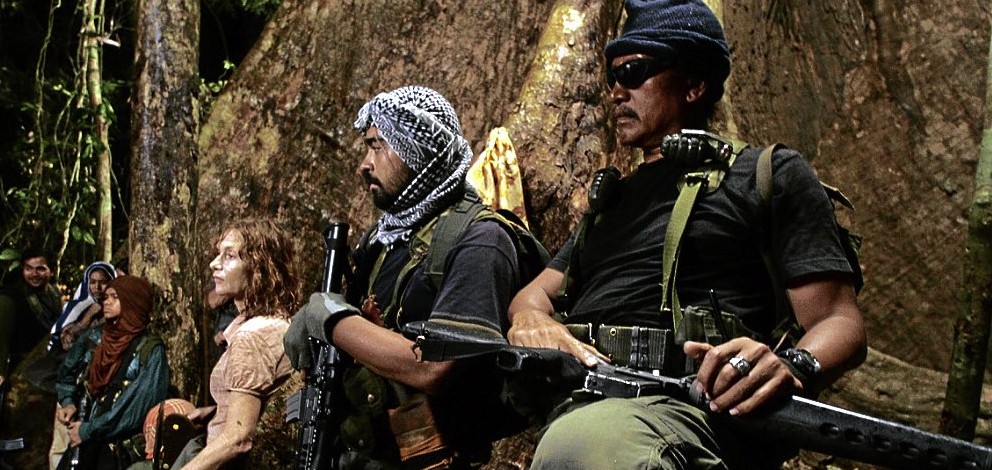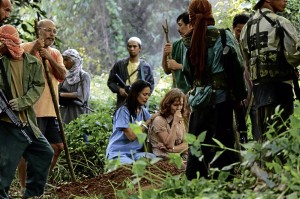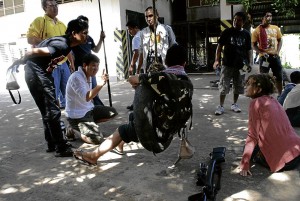

Brillante Mendoza recreates compellingly the horrors of the 2001 Abu Sayyaf kidnapping in “Captive,” perhaps the most forthright movie made yet on the Muslim Mindanao problem. Freely drawing from Gracia Burnham’s 2003 book, “In the Presence of My Enemies,” which details the 377-day ordeal that the Protestant missionary and her husband Martin suffered at the hands of the Abu Sayyaf, the 2009 Cannes Film Festival best director weaves a fictional account of the infamous abduction that has, however, the tug and horror of the real thing. The result is the most realistic cinematic treatment yet of Muslim terrorism.
A French-Filipino-German-British co-production, “Captive” recasts Gracia Burnham as Therese Burgeoine, a Christian missionary and social worker portrayed by the celebrated French actress Isabelle Huppert. Although Burgeoine is married, her husband and children are back home and she’s abducted with her old local guide (a very energetic Rustica Carpio).
Together with locals and other foreigners, Therese is brought to the high seas through a kumpit (speedboat) and transferred to an outrigger. The band go inland and occupy the Dr. José Maria Torres Hospital and the adjacent St. Peter’s Church in Lamitan, Basilan, where they demand ransom from the authorities. Therese witnesses the payment of the ransom by local and military authorities, replicating the controversial passages in Burnham’s book in which she claims that military officers were demanding a cut from the ransom and aided the Abu Sayyaf in their kidnap-for-ransom operations.
Despite the payment, the military mysteriously orders an assault of the hospital and the church. Still, the rebels with hostages in tow, slip through, enforcing the claims of the real victims that the military had allowed the terrorists to escape because officers were on the take and had gotten a cut from the ransom. “Captive” shows that the assault may be just the military’s way of demanding a bigger cut or a mere mock battle staged for the media. As helicopters rain fire on the hospital from a distance, the terrorists and their hostages leisurely make the trek to the jungles, with one prisoner (Archie Adamos) incredulous at the sight, “Who are they fighting there?” (Abu Sabaya, the terrorist leader, claimed that he and his comrades had paid local and military officials to allow them to escape.)
As the abductors take them deeper into the jungles of Basilan, Therese and the other prisoners go deeper into the heart of darkness. A year later, she breaks down before the camera during an interview with broadcast journalist Arlyn de la Cruz, who plays herself in the movie to reprise the controversial interview she did of the Burnhams in 2001. “It has been long,” Therese says. “It’s a mystery,” the other foreign captives say. Despite the constant reminders that the military is in hot pursuit of the terrorists and their captives, the European prisoners complain that they have not been rescued or released.
Protracted conflict

In focusing on the hostages’ extended captivity, Mendoza adumbrates the protracted state of things that have allowed the Muslim Mindanao conflict to fester and for kidnap-for-ransom terrorist gangs to flourish. Secessionism has lasted for two generations but there’s no end in sight to the problem largely because the military has been cashing in on the conflict, as proven by reports of the officers selling arms and ammunition to the rebels and pocketing kickbacks from logistics and military procurement.
The government and the military have even managed to profit from kidnap-for-ransom incidents. In her book, Burnham writes that members of the Armed Forces of the Philippines provided rice, sugar and other food for the bandits. She says she was told it was because the Abu Sayyaf was “wheeling and dealing” with the general in the region, who wanted a cut of the ransom. She adds the bandits offered 20 percent, but that the general wanted 50 percent.
The movie likewise shows that ransom had indeed been paid for the release especially of affluent prisoners, like businessman Reghis Romero, despite denials by authorities. (Sen. Sergio Osmeña III, in late 2001, said he helped deliver P17 million in ransom to the Abu Sayyaf bandits for the release of businessman Romero in June. “I know ransom was paid by Reghis Romero because [the government] used my help in paying the ransom,” he said.)
The movie reminds us that the Dos Palmas incident took place three months before 9/11 and prefigured the horrors of Islamic extremism, and that the Abu Sayyaf was allied with the Moro Islamic Liberation Front and the Al Qaida. The movie shows the terrorists entering MILF-protected territories and accepting a cache of high-powered firearms from Arab guests who promise to send more aid soon. (In her book, Burnham writes that her captors told Martin Burnham to say in a ransom message that he was being held by “the Osama bin Laden group.”) A short scene shows the European captives huddled over the terrorists’ radio and hearing the Twin Towers attack and Therese asking incredulously, “They’re now even attacking America?” while the Abu Sayyaf men cheer fanatically, “Allah Akbar!”
No exaggeration
Mendoza doesn’t exaggerate the meanness of the terrorists. His detached, journalistic style catches snatches of their religious zealotry while also showing their human side. Against the general harshness of his men, the leader (Raymond Bagatsing) is gallant and gentlemanly, apologizing to patients in a medical ward for the Abu Sayyaf’s occupation of the hospital. But he also proclaims the tenets of Islam with matter-of-fact severity and imposes them on the captives. He intones, for example, the four options of Islam for prisoners of war—to be killed, to be taken as slaves, to be converted, or to be taxed—and sums up perfectly the Abu Sayyaf’s twisted ways. Kidnap-for-ransom becomes for them a perfect option to make a living while fighting for their patriotic dream of a Bangsa Moro republic and practicing their strict observance of Islam!
Occasionally there will be snatches of black humor as when one of the bandits teaches Therese how to use the malong (southern weave) to cover herself and practice feminine modesty according to Muslim strictures; and when in the heat of the military raid of the Lamitan hospital, the terrorist negotiator Abu (Ronnie Lazaro, in a very credible performance) gives Therese the mobile phone to call her embassy for it to urge Philippine authorities to stop the attack by invoking the Geneva convention banning attacks on hospitals.

Humanity
Amid the carnage and the protracted dehumanization they’re subjected to, the abducted admirably maintain their humanity. They share food and meager provisions; the nurse and medical internees apply emergency treatment on those wounded by crossfire while themselves being exposed to the same risk; the Europeans band together and provide comfort to one another, especially when it becomes increasingly evident that their governments won’t relent in their no-ransom policy. (“If you are still here and miserable, blame your government,” the enraged Abu Sayyaf negotiator tells them.)
Therese maintains her sanity through all the difficult order by keeping in touch with her humanity. Although she never loses her objectivity and relaxes her contempt for her captors, she befriends Hamed, the boy warrior who retrieved her slippers which she had lost during one of several encounters between the Abu Sayyaf and the army. She treats his wounds and he later sufficiently warms up as to confide to her that he has never gone back to studies since the time he got home from school and found his parents dead, slain by the army.
Visual-language mastery
Those who have accused Mendoza of sadomasochistic filmmaking in “Kinatay” and “Serbis” should watch “Captive.” Confronted with a real-life terrorist incident of unmitigated horror and protracted torment, Mendoza displays mastery of visual language and skillfully calibrates sequences of carnage and atrocity with neither sensationalism nor fakery.
When the Abu Sayyaf decides to execute a Caucasian hostage for stepping on the Quran and to break an impasse in the negotiations, the violence is prefigured in a montage of the younger terrorists playing games and decapitating the head of a jungle lizard. The terrorist leaders replay the brag of the real Abu Sayyaf when they killed the American Guillermo Sobero in 2001: “We will send his head to President Macapagal-Arroyo as gift for Philippine Independence Day!”
Which does not mean Mendoza scrimps on the violence. As always, the director of “Kinatay” does not obscure or prettify the horrors of an inherently violent situation. He shows the new emir decapitating a soldier, the latter’s hacked nape starkly visible in close-up, and raping the married nurse (Angel Aquino). He shows the Abu Sayyaf hacking the security guards from Dos Palmas as they try to run for their lives. He shows the violence of hostilities in battle scenes that are the most realistic yet in Philippine cinema.
As always, too, Mendoza draws from his exceptional skills as production designer and cinematographer to make the setting and background throb with life and embody the travails of the prisoners. In “Captive,” he makes the forest pulse with enigmatic, even sinister beauty. A breathtaking overhead shot of the forest and the nearby lake hovers in the air and then dips down toward the crown of trees, then down land further, showing Therese recently roused from her sleep, with giant ants at her feet; and as she turns, she finds the threatening ants dotting Soledad’s sleeping figure. When she wakes her up, she finds her faithful companion dead out of exhaustion.
Similarly, Mendoza shows deadly scorpions crawling at the feet of the captives, representing the danger that perennially lies in wait for them at the jungle. Moreover, after the rebels ambush and wipe out a whole platoon of army soldiers, Mendoza presents the montage of a snake ensnaring a bird, then going quickly for the kill.
Isabelle Huppert
As Therese, Huppert admirably delivers an extremely physically draining and emotionally demanding performance. Never for once taken by the terrorists’ charm and braggadocio, Therese maintains her objectivity all throughout and like Gracia Burnham who titled her book “In the Presence of My Enemies,” never for once mistake the enemy for a friend. Huppert’s frightening character in Chabrol’s “Merci Pour le Chocolat” uttered the immortal line, “I have a knack for doing something wrong.” In Mendoza’s “Captive,” Huppert’s character shows a knack for getting into an awfully wrong situation but prevailing nevertheless, come what may.
Her ordeal may have been alleviated by the occasional kindness of strangers and the beauty of the forest, but Therese knows she’s going through hell and should bear it with Christian faith and hope. In a crucial scene, she wakes up with Hamed beside her, her unlikely surrogate son, and relieving herself, catches sight of the Sarimanok, the mythical Maranao bird. When she follows the beautiful bird into a clearing, she is awoken from her reverie by Hamed pointing a gun at her and accusing her of trying to flee.
The scene of magic realism, so rare in the mercilessly coruscating cinema of Brillante Mendoza, sums up the sense of unreality that characterizes the violence in Mindanao. In such a situation, illustrated many times over—by Joan the nurse forced to marry the terrorist leader, and by the male Muslim nurse drafted into the Abu Sayyaf much against his will—there’s really not much choice. Everyone becomes a captive of one’s unrelentingly incomprehensible situation.












































